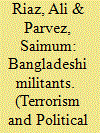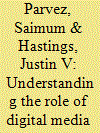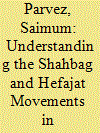|
|
|
Sort Order |
|
|
|
Items / Page
|
|
|
|
|
|
|
| Srl | Item |
| 1 |
ID:
163210


|
|
|
|
|
| Summary/Abstract |
Although militant groups have been present in Bangladesh since the 1990s, the country catapulted to international media attention on July 1, 2016, after an attack on a café in the upscale neighborhood of the capital Dhaka. The Islamic State claimed responsibility for the attack which killed 29 people, mostly foreigners. The attack came in the wake of a series of attacks on religious and ethnic minorities, foreigners, liberal activists, authors, and publishers by both an AQIS affiliate and ISIS. The government denied the existence of militant groups tied to international terrorist organizations. Despite these developments and instances of Bangladeshis joining the ISIS in Iraq and Syria, there has been very little in-depth discussion about who these militants are and what is driving Bangladeshis to militancy. This article addresses this lacuna. This paper examines the common traits of alleged Bangladeshi militants and explores the factors of radicalization. Drawing on media reports of the profiles of the alleged militants, between July 2014 and June 2015, and between July 2016 and August 2017, the article finds that most of the Bangladeshi militants are young, educated males increasingly coming from well-off families. We have also found evidence that four factors—social relationships, use of the Internet, personal crises, and external relations—appear most frequently in the narratives of Bangladeshi
|
|
|
|
|
|
|
|
|
|
|
|
|
|
|
|
| 2 |
ID:
188329


|
|
|
|
|
| Summary/Abstract |
Notwithstanding the discernable participation of women in terrorist groups, empirical research on women in terrorism is very scant in Bangladesh. To fill this gap, our article examines women’s involvement in terrorism by analyzing the life stories of dozens of Bangladeshi women terrorists. We use a terrorist lifecycle approach to understand the role of digital media in female participation, particularly in terms of when in the lifecycle digital media becomes important, and in terms of how digital media interacts with other factors to shape women’s involvement in terrorist organizations. After analyzing female profiles and their socio-demographic traits, we provide an in-depth analysis of three female terrorist lifecycles. An analysis of the profiles of Bangladeshi terrorists who use digital media reveals that women were more likely to use digital media than men in the recruitment phase. The in-depth case studies of three female terrorist profiles find that multiple and different factors impact their terrorist life cycles. Social networks – families and friends – typically play a role in individuals’ decision to become involved and further engagement in terrorism. Specifically, digital media allows women to expand their social interactions beyond what is possible in person, thus allowing for virtual pathways into terrorism.
|
|
|
|
|
|
|
|
|
|
|
|
|
|
|
|
| 3 |
ID:
185149


|
|
|
|
|
| Summary/Abstract |
This study examines the role of the press in shaping national identities in contemporary Bangladesh. It employs the critical discourse analysis method to analyze newspapers’ content and closely examines the news texts of three high-profile events in 2013: the Shahbag movement, the murder of blogger Rajib, and the Hefajat movement. Based on the critical discourse analysis of newspaper articles related to these three events, this study observes a discursive construction of two binary and intolerant identities in the coverage. This analysis demonstrates how the discourse of each newspaper creates meanings related to national identities and ideologies that serve to justify the interests of ‘us’ and to criticize ‘them’.
|
|
|
|
|
|
|
|
|
|
|
|
|
|
|
|
|
|
|
|
|